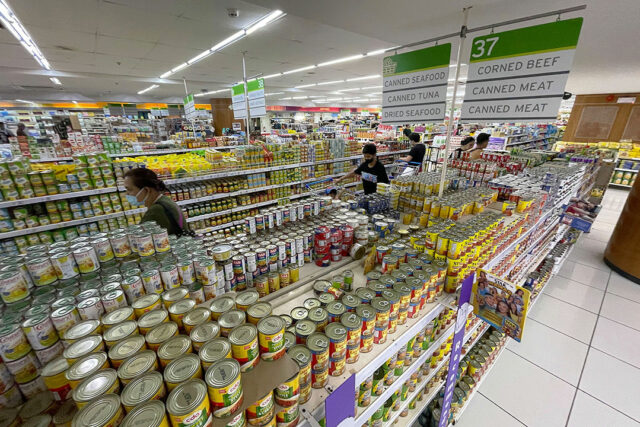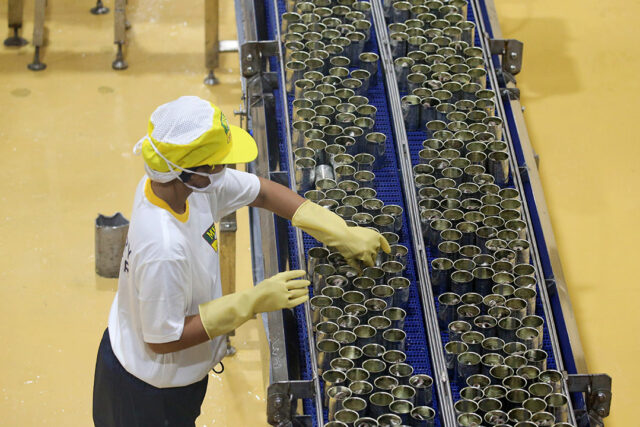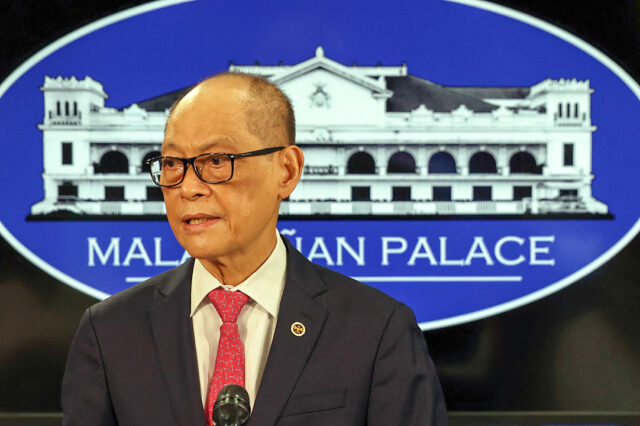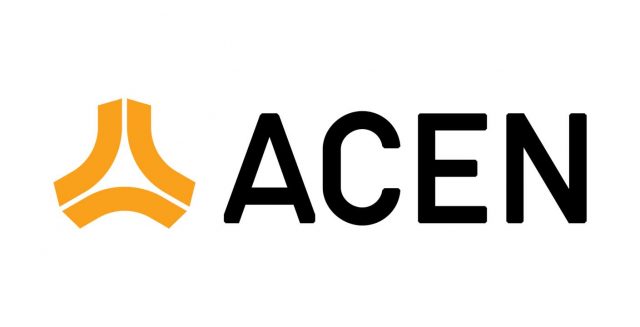By Luisa Maria Jacinta C. Jocson, Reporter
A RECOVERY in government spending helped the Philippine economy bounce back in the third quarter, putting it on track to post the fastest growth in Southeast Asia this year.
Preliminary data from the Philippine Statistics Authority (PSA) showed that gross domestic product (GDP) expanded by 5.9% in July to September, faster than 4.3% in the second quarter but slower than 7.7% a year earlier.
This also exceeded the 4.9% median estimate of 18 economists in a BusinessWorld poll last week.
 The expansion in the third quarter also ended three consecutive quarters of slowing growth.
The expansion in the third quarter also ended three consecutive quarters of slowing growth.
The Philippines’ third-quarter GDP growth is the fastest among major emerging economies in Asia with available data, National Economic and Development Authority (NEDA) Secretary Arsenio M. Balisacan told a press briefing
With 5.9% GDP growth, the Philippines was ahead of Vietnam (5.3%), Indonesia and China (4.9%), and Malaysia (3.3%).
For the first nine months, economic growth averaged 5.5%, still below the government’s 6-7% full-year target.
“The economy will need to grow by 7.2% year on year in the fourth quarter of 2023 to attain at least the low end of the government’s target,” Mr. Balisacan said.
On a seasonally adjusted quarterly basis, Philippine GDP grew by 3.3%, a turnaround from the 0.7% contraction in the second quarter.
The Philippines’ third-quarter economic performance was driven by a recovery in government spending, which helped offset weaker household consumption.
Government spending jumped by 6.7%, faster than 0.7% a year ago and a turnaround from the 7.1% contraction in the second quarter.
Mr. Balisacan said government agencies’ catch-up plans helped ramp up spending last quarter.
The PSA said state expenditures contributed 2.1 percentage points to GDP growth, equivalent to 36%.
Household consumption, which accounted for about three-fourths of the economy, grew by 5% in the third quarter — the weakest in two years. This was also slower than 8% a year ago and 5.5% in the previous quarter.
“The domestic demand slowdown is primarily because of the higher uptick in inflation. Now that we are succeeding in reducing that inflation, we believe that domestic demand will improve this quarter and in the quarters ahead,” Mr. Balisacan said.
An uptick in inflation was seen in August and September, as prices of food and fuel spiked. In September, headline inflation accelerated to 6.1% from 5.3% in August.
Data from the PSA showed that the main contributors to household spending were transport; miscellaneous goods and services; restaurants and hotels; housing, water, electricity, gas and other fuels; and education.
Gross capital formation — the investment component of the economy — slipped by 1.6%, ending nine straight quarters of growth. This was a reversal of the 18.2% expansion a year ago and 0.3% in the second quarter.
Mr. Balisacan said this was due to the substantial drawdown in inventories, as well as the slowdown in durable equipment (1.75% from 10.5%).
“These outweighed the faster growth in both public construction which grew by 26.9% from 0.7% and private construction which grew by 5.1% from 4.3%,” he added.
Exports of goods and services grew by 2.6% in the July-September period, slower than 13.6% a year earlier and 4.4% in the previous quarter.
On the other hand, imports shrank by 1.3%. This was its first contraction since the first quarter of 2021. It was also a reversal of 18.5% growth in the third quarter of 2022 and 0.2% a quarter earlier.
Net primary income from the rest of the world jumped by 112.5%, higher than 95.1% a year ago and 90.7% in the second quarter.
Gross national income, the sum of the country’s GDP and net income received from overseas, climbed by 12.1%. This was higher than 10.6% a year earlier and 8.6% in the previous quarter.
On the production side, all sectors posted growth in the third quarter. Services expanded by 6.8%, slowing from 9.3% a year ago but faster than 6.1% in the second quarter.
“Services remained to have the highest share to the total GDP in the third quarter of 2023 with 65.1%, which was higher than the 64.6% share in the same period of 2022,” the PSA said.
Industry growth eased to 5.5% from 5.8% a year earlier. However, this was faster than 2.1% in the second quarter.
Agriculture, forestry, and fishing inched up by 0.9%, slower than 2.1% a year ago but better than 0.2% in the previous quarter.
‘STILL DOABLE’
Meanwhile, Mr. Balisacan remained optimistic, saying the government’s 6-7% growth goal this year is “still doable” and “still within reach.” However, challenges to the outlook include geopolitical tensions and persistent inflation.
Any changes to the Development Budget Coordination Committee’s (DBCC) macroeconomic assumptions will also not be substantial.
“We will be close to most of the major assumptions, particularly GDP growth,” Mr. Balisacan said.
The DBCC will meet in December for its final review of targets.
For the last quarter, Mr. Balisacan said easing inflation would help boost household consumption ahead of the holiday season.
“In October, (inflation) is going down, so if we continue along that direction there, we should be able to take advantage of revenge spending as a driver of growth,” he said. “Inflation is the key in the revival of the robust growth in consumption and so the focus is ensuring that reduction in inflation,” he added.
Mr. Balisacan also said there is still a need to improve government spending and investment.
Security Bank Corp. Chief Economist Robert Dan J. Roces in a Viber message said growth is expected to remain subdued in the next quarters amid “cooling of external demand and the impact of elevated interest rates.”
Makoto Tsuchiya, assistant economist at Oxford Economics, said in a note he expects growth to slow in the quarters ahead due to the global economic slowdown.
“GDP rebounded strongly in the third quarter of the year, but we don’t expect this strength to last as high interest rates and weaker global growth lead to renewed economic weakness in the coming quarters,” Gareth Leather, senior Asia economist at Capital Economics, likewise said in a note.
In a note, ANZ Research said private consumption would continue to be the main driver of growth. However, it expects this to “weaken further amidst softening consumer sentiment and stabilization in remittance income.”
BMI, a unit of Fitch Solutions, said it expects growth to remain flat in the fourth quarter. “Still, we think that government projections of 6.5-8% in 2024 might prove a little too optimistic due to several headwinds,” it added.
ING Bank N.V. Manila Senior Economist Nicholas Antonio T. Mapa said the better-than-expected third-quarter growth would allow more room for additional tightening by the BSP.
“Robust growth coupled with hawkish statements from BSP Governor Eli M. Remolona, Jr. points to at least one more rate hike before the end of the year and possibly two should BSP’s inflation forecasts for 2024 remain elevated,” he said in a note.
Mr. Mapa said the BSP would likely hike rates at its next meeting on Nov. 16 before raising rates to 7% at its final meeting for the year in December.
Security Bank’s Mr. Roces cautioned that further tightening could dampen economic activity.
“This tightening of monetary policy, although essential to temper inflation, comes with the risk of slowing down economic momentum, particularly in interest-sensitive sectors such as capital formation and consumer spending. With this, we think the BSP will pause in the upcoming policy meeting,” he said.
Last month, the Monetary Board raised borrowing costs by 25 basis points (bps) in an off-cycle move. This brought the benchmark interest rate to a 16-year high of 6.5%.
The BSP has raised interest rates by 450 bps since May 2022 to fight inflation.
The central bank on Tuesday said in a statement it would “keep monetary policy settings sufficiently tight until inflation expectations are better anchored and a sustained downtrend in inflation becomes evident.”













